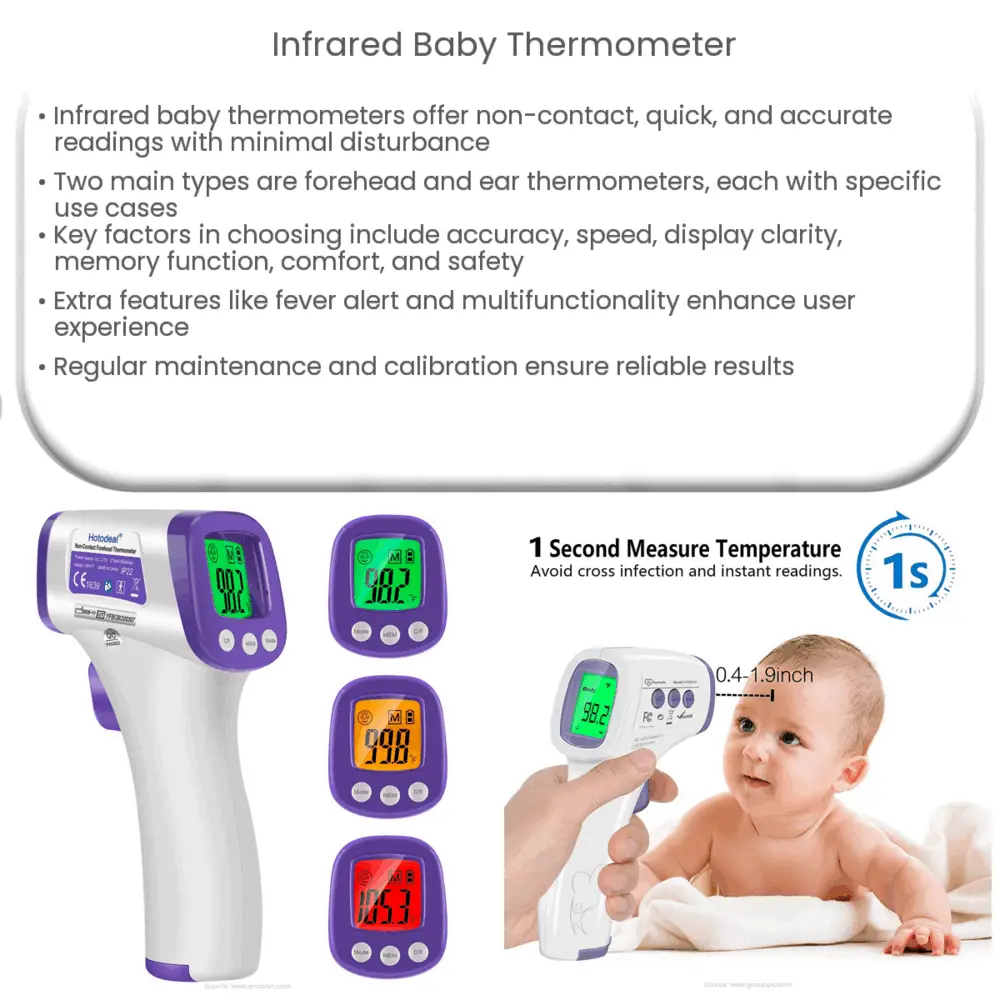Infrared baby thermometers offer quick, non-contact temperature readings, ensuring accuracy and minimal disturbance for infants.

Infrared Baby Thermometers: A Comprehensive Guide
An infrared baby thermometer is an essential tool for parents and caregivers alike, as it allows for quick, non-contact temperature measurements. This guide will provide an overview of the benefits of using an infrared baby thermometer, how they work, and tips for choosing the best one for your needs.
Benefits of Infrared Baby Thermometers
When it comes to taking a baby’s temperature, an infrared thermometer offers several advantages over traditional methods:
- Non-contact: Infrared thermometers allow you to measure a baby’s temperature without touching their skin, reducing the risk of spreading germs and avoiding unnecessary discomfort.
- Quick and Easy: Infrared thermometers provide results in just seconds, making them an efficient tool for monitoring a baby’s health.
- Accuracy: These thermometers are designed to provide accurate readings within a small margin of error, giving parents peace of mind.
- Minimal Disturbance: Because they don’t require physical contact, infrared thermometers can be used while a baby is asleep, ensuring minimal disturbance to their rest.
How Infrared Baby Thermometers Work
Infrared thermometers work by measuring the infrared energy emitted by an object, in this case, a baby’s forehead or ear. The device has a sensor that detects this energy, which is then converted into a temperature reading. This technology enables the thermometer to provide quick and accurate measurements without the need for physical contact.
Types of Infrared Baby Thermometers
There are two main types of infrared baby thermometers:
- Forehead Thermometers: These thermometers are designed to measure the temperature of the temporal artery located on the baby’s forehead. To use this type of thermometer, simply hold it a few centimeters away from the forehead and press the button to obtain a reading.
- Ear Thermometers: Ear thermometers measure the temperature of the tympanic membrane in the baby’s ear canal. To use this type of thermometer, gently insert the probe into the ear canal and press the button to obtain a reading. This method is typically more accurate but may not be suitable for newborns or babies with ear infections.
Choosing the Right Infrared Baby Thermometer
When selecting an infrared baby thermometer, consider the following factors:
- Accuracy: Look for a thermometer that provides accurate readings within a small margin of error (usually ±0.2°C or ±0.4°F).
- Speed: Opt for a device that provides results in just a few seconds to minimize disruption and discomfort for the baby.
- Display: A thermometer with a clear and easy-to-read display can make it simpler to interpret the results, especially in low-light conditions.
- Memory Function: Some thermometers come with a memory function that stores previous readings, allowing for easy tracking of a baby’s temperature over time.
- Comfort and Safety: Choose a thermometer that is designed with baby’s comfort and safety in mind, such as one with a flexible tip or a no-touch option.
Additional Features to Consider
While not essential, some infrared baby thermometers come with extra features that can enhance the overall user experience:
- Fever Alert: Some models include a fever alert system that changes the display color or emits an audible signal when a high temperature is detected, making it easier for parents to identify potential health concerns.
- Multifunctionality: Certain thermometers can also measure the temperature of objects, liquids, and ambient air, providing added versatility for parents.
- Automatic Shutoff: A thermometer with an automatic shutoff feature can prolong battery life by turning off the device after a period of inactivity.
- Backlit Display: A backlit display can make it easier to read the thermometer in low-light situations, such as during nighttime temperature checks.
Maintaining and Cleaning Your Infrared Baby Thermometer
Proper maintenance and cleaning of your infrared baby thermometer are essential for ensuring accurate and reliable readings. Follow these tips to keep your device in good working order:
- Storage: Store your thermometer in a cool, dry place, away from direct sunlight or extreme temperatures. Keep the device in its protective case, if provided, to prevent damage.
- Cleaning: Regularly clean the thermometer’s sensor or probe using a soft cloth or cotton swab dampened with rubbing alcohol. Avoid using water, as it can damage the sensor. Allow the thermometer to dry completely before using it again.
- Battery Replacement: Replace the batteries as needed to ensure consistent performance. Some thermometers feature a low-battery indicator to notify you when it’s time for a replacement.
- Calibration: Periodically check the accuracy of your thermometer by comparing its readings with those of a trusted device. If the readings are significantly different, consult the manufacturer’s instructions for information on recalibration or contact customer support for assistance.
Conclusion
An infrared baby thermometer is a valuable tool for monitoring your child’s health and well-being. By understanding the various features, types, and factors to consider, you can select the right device for your needs. Remember to maintain and clean your thermometer regularly to ensure accurate and reliable readings. With the proper care and attention, an infrared baby thermometer can provide peace of mind for parents and caregivers alike.

